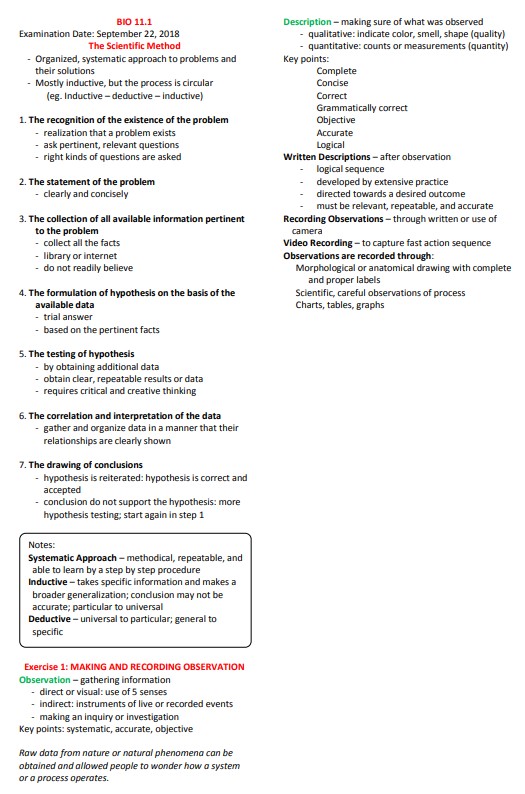Biology Laboratory Introduction
Summary:
This Biology Laboratory Introduction note summarises the introduction to the general biology laboratory course. It covers the scientific method, making and recording observations, and using the microscope.
The scientific method is described as an organized and systematic approach to problem-solving. It involves recognizing the existence of a problem, stating the problem clearly, collecting relevant information, formulating hypotheses, testing hypotheses through data collection, correlating and interpreting the data, and drawing conclusions. The process is iterative and requires critical and creative thinking.
Exercise 1 focuses on making and recording observations. Observations can be direct (using the five senses) or indirect (using instruments or recorded events). Key points for observations include being systematic, accurate, and objective. Descriptions should be qualitative or quantitative, complete, concise, correct, grammatically correct, objective, accurate, and logical. Observations can be recorded through written descriptions, morphological or anatomical drawings, scientific observations of processes, charts, tables, graphs, or video recordings.
Exercise 2 introduces the use of the microscope. Anton Van Leeuwenhoek’s contribution to microscopy is mentioned, and the definition of key terms is provided. These terms include magnification, linear magnification, resolving power, limit of resolution, numerical aperture, refractive index, working distance, and field of vision. The note also presents a formula for calculating magnification and discusses the theoretical and actual magnification.
Common mistakes in writing observations are highlighted, including anthropomorphism, unscientific descriptions, and grammatical errors. An organized format example for writing observations is provided, covering form, environment, behaviour, and conclusion.
Excerpt:
Biology Laboratory Introduction
BIO 11.1
Examination Date: September 22, 2018
The Scientific Method
– Organized, systematic approach to problems and their solutions
– Mostly inductive, but the process is circular (eg. Inductive – deductive – inductive)
1. The recognition of the existence of the problem
– the realization that a problem exists
– ask pertinent, relevant questions
– right kinds of questions are asked
2. The statement of the problem
– clearly and concisely
3. The collection of all available information pertinent to the problem
– collect all the facts
– library or internet
– do not readily believe
4. The formulation of the hypothesis on the basis of the available data
– trial answer
– based on the pertinent facts


Reviews